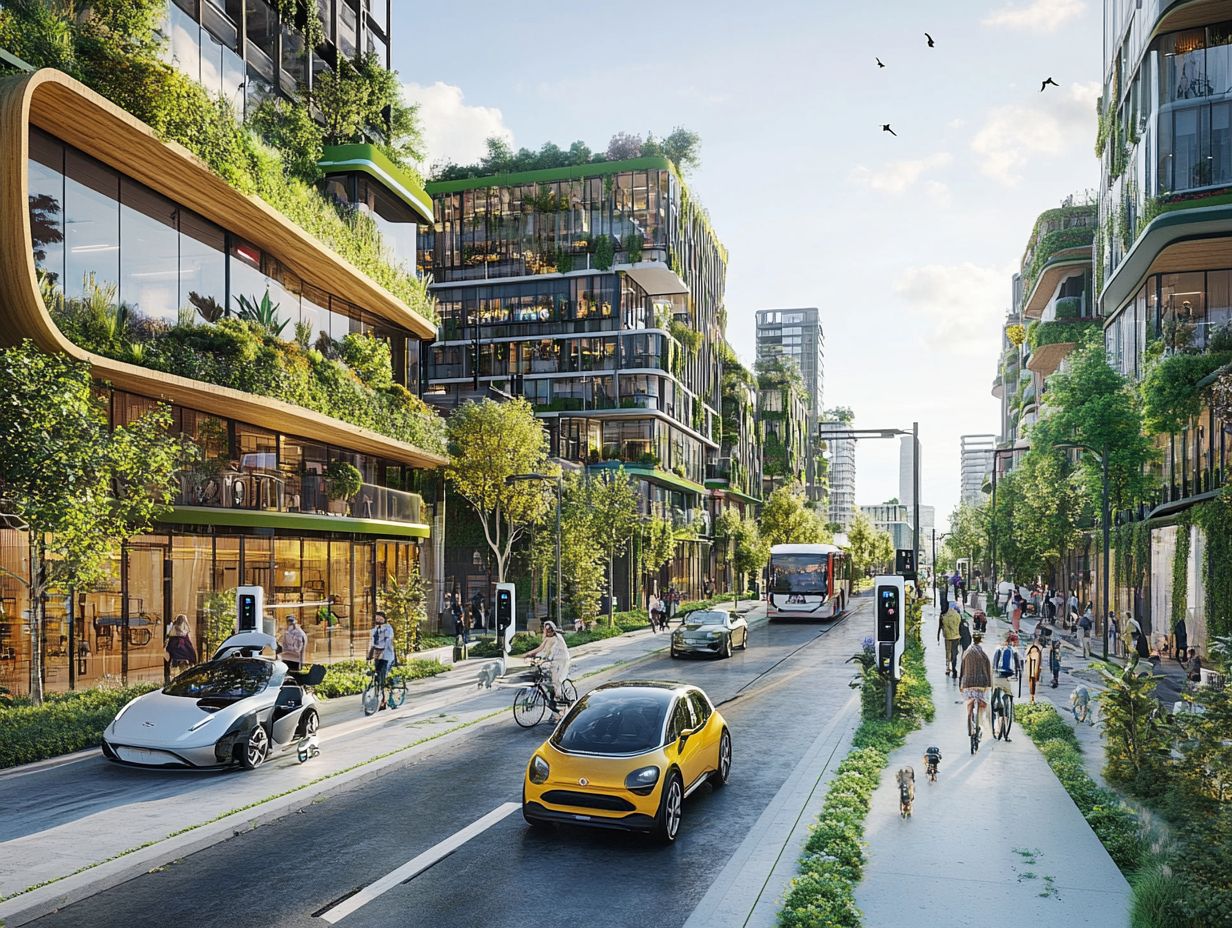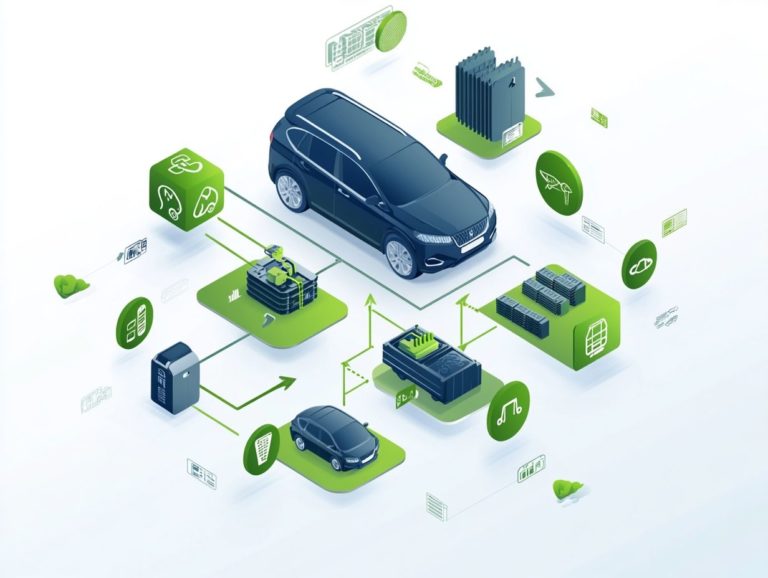Sustainable Urban Mobility and Electric Vehicles
Sustainable urban mobility is becoming increasingly critical as you navigate the challenges of congestion, pollution, and climate change in your city. Electric vehicles (EVs) present a promising solution, offering a pathway to reduce emissions and enhance the overall quality of life for urban residents like yourself.
This discussion delves into the importance of sustainable urban mobility, shedding light on how EVs operate, their numerous benefits, and the hurdles that come with their adoption. It will also address how government policies can champion EV usage and help envision a greener future for urban transportation.
Let s dive into this important topic that impacts your city and the entire planet.
Contents
- Key Takeaways:
- The Importance of Sustainable Urban Mobility
- Benefits of EVs for Sustainable Urban Mobility
- Challenges and Solutions for EV Adoption
- Promoting the Use of EVs in Cities
- Future of Sustainable Urban Mobility with EVs
- Frequently Asked Questions
- 1. What is sustainable urban mobility and why is it important?
- 2. How do electric vehicles play a role in sustainable urban mobility?
- 3. Are there any benefits to using electric vehicles in cities?
- 4. Do electric vehicles have a limited range compared to traditional vehicles?
- 5. Can electric vehicles be charged at home?
- 6. How do electric vehicles contribute to a more sustainable future?
Key Takeaways:

- Sustainable urban mobility is crucial for preserving the environment and improving quality of life.
- Electric vehicles (EVs) play a vital role in achieving sustainable urban mobility by reducing emissions and improving air quality.
- The adoption of EVs in cities faces challenges such as infrastructure and cost, but these can be overcome with government policies and incentives.
The Importance of Sustainable Urban Mobility
Sustainable urban mobility is essential for tackling the challenges faced by modern cities. Integrating electric vehicles (EVs) can dramatically enhance urban transportation systems, decrease greenhouse gas emissions, and boost public health. For more insights, explore the future of sustainable mobility and electric vehicles.
As cities like New York City shift toward cleaner, more eco-friendly transport solutions, the significance of smart city initiatives in promoting electric mobility grows ever more crucial. By prioritizing environmental stewardship and implementing complete transportation systems, city governments can cultivate a seamlessly connected and efficient transport landscape that caters to the needs of their populations while effectively minimizing their carbon footprint.
Effects on Environment and Quality of Life
The impact of greenhouse gas emissions from traditional transportation methods has led to notable public health challenges and environmental concerns, especially in densely populated urban areas.
These emissions contribute to a variety of respiratory diseases, such as asthma and bronchitis, hitting the most vulnerable populations like children and the elderly hardest. The relentless noise pollution from internal combustion engines doesn t help either; it amplifies stress levels and can lead to additional health issues.
The good news is that electric vehicles offer a fantastic solution. They not only significantly cut down on harmful emissions but also enhance traffic flow by providing a quieter, more efficient driving experience. As cities transition towards electric mobility, you can look forward to cleaner air, a reduced carbon footprint, and an overall improved quality of life, paving the way for healthier and more sustainable urban environments.
What are EVs and How Do They Work?
Electric vehicles (EVs) represent a leap forward in transportation, utilizing electric motors powered by advanced battery technology. They offer a sustainable alternative to conventional internal combustion engines, transforming the way you think about mobility.
These state-of-the-art vehicles tap into electric energy stored in various battery types, from lithium-ion to cutting-edge solid-state options. This choice significantly impacts their performance and efficiency. The electric motors deliver torque the force that makes the vehicle move and provide instant acceleration, making your driving experience not just responsive, but genuinely enjoyable. With the emergence of diverse EV types, including electric bicycles and GEM electric vehicles, you have a wealth of options tailored to your lifestyle and needs.
The evolution of charging infrastructure includes fast-charging stations and home charging units, greatly enhancing the convenience of owning an electric vehicle. This development fosters a stronger shift towards eco-friendly transportation solutions, aligning with a more sustainable future.
Benefits of EVs for Sustainable Urban Mobility

Electric vehicles (EVs) present a wealth of advantages for sustainable urban mobility. They significantly reduce emissions and contribute to improved air quality. Additionally, they offer a quieter, more serene transportation experience in the heart of bustling cities.
Reducing Emissions and Improving Air Quality
Switching to electric vehicles is essential. It helps reduce harmful emissions such as particulate matter and nitrogen oxides, which contribute to air pollution and health issues.
By making the shift to electric vehicles, your city can dramatically decrease its overall greenhouse gas output. This creates a ripple effect that enhances urban air quality.
Cleaner air benefits the environment and directly improves residents’ health, especially in densely populated areas where smog and respiratory issues are common.
As air quality improves, you ll see fewer cases of asthma, cardiovascular diseases, and other health risks linked to pollution. By embracing this change, your community can enjoy better health and well-being!
Challenges and Solutions for EV Adoption
Despite the appealing advantages of electric vehicles, challenges like range anxiety and insufficient charging infrastructure frequently obstruct their widespread adoption in urban environments.
Infrastructure and Cost Considerations
Developing strong charging infrastructure is crucial for the widespread adoption of electric vehicles. This not only addresses cost considerations but also alleviates concerns about charging accessibility in urban areas.
By enhancing fast-charging stations and establishing comprehensive charging networks, you can significantly reduce range anxiety for potential EV users. This makes electric mobility a far more appealing choice.
This improvement benefits you as an individual consumer by lowering your overall vehicle operating costs. It also positions municipalities to attract cleaner transportation initiatives.
Public transport systems can benefit immensely as well. With improved EV infrastructure, cities can reduce emissions, lower operating expenses, and enhance service efficiency.
By investing in charging solutions, municipalities are paving the way for a sustainable future while creating economic opportunities within their communities.
Promoting the Use of EVs in Cities

Promoting the adoption of electric vehicles in urban areas hinges on implementing strong government policies and rewards that inspire both consumers and businesses to embrace sustainable transportation options.
By creating a framework that prioritizes eco-friendly solutions, you can facilitate a shift toward a greener future and encourage a collective move away from traditional fossil fuel reliance.
Government Policies and Incentives
Government policies are crucial in driving the transition to electric vehicles. They are especially important for reducing emissions and promoting clean transport within the transportation sector.
By offering substantial rebates for electric vehicle purchases and grants designed to enhance charging infrastructure, governments are actively nudging you toward making the switch. For example, California s Clean Vehicle Rebate Project has enabled thousands of electric vehicle sales.
Meanwhile, cities like Seattle are raising the bar with stringent emission regulations that require public agencies to invest in electric buses.
Federal commitments to establish nationwide charging stations are also reshaping consumer perceptions and market dynamics. These targeted incentives make electric vehicles more attainable for you and lay down a robust framework that champions a sustainable future in urban mobility.
Join the movement towards cleaner transportation! Advocate for electric vehicle policies in your city today!
Future of Sustainable Urban Mobility with EVs
The future of sustainable urban mobility is closely connected to the dynamic evolution of electric vehicles. These vehicles are set to integrate effortlessly with autonomous driving technologies, smart city innovations, and renewable energy sources, aligning with the future of transportation to create a harmonious ecosystem for transportation.
Potential Impact and Growth Opportunities
The impact of electric vehicles on urban mobility is enormous, presenting a wealth of growth opportunities from innovations in smart city planning and the evolution of autonomous vehicles, as explored in the intersection of EVs and sustainable energy systems.
As cities prioritize sustainability, integrating electric vehicles significantly reduces air pollution and alleviates traffic congestion, fostering healthier living environments.
The relationship between electric vehicles and advancements in smart city technologies allows for efficient transportation networks that optimize traffic flow using real-time data.
This transition boosts the emergence of autonomous vehicle technology, transforming public transit systems and paving the way for comprehensive urban planning strategies that accommodate innovative modes of transport.
Frequently Asked Questions

-
1. What is sustainable urban mobility and why is it important?
Sustainable urban mobility promotes environmentally-friendly and efficient transportation in cities. It helps reduce air pollution, traffic congestion, and improves public health, contributing to a more livable city, especially at the intersection of EVs and smart cities.
-
2. How do electric vehicles play a role in sustainable urban mobility?
Electric vehicles (EVs) are crucial for sustainable urban mobility as they produce zero emissions and do not contribute to air pollution. They also reduce reliance on fossil fuels and promote renewable energy use, highlighting the role of electric vehicles in sustainable transportation.
-
3. Are there any benefits to using electric vehicles in cities?
Yes, using electric vehicles offers many benefits, including lower operating costs, reduced noise pollution, and improved air quality. EVs also have lower carbon emissions compared to traditional gasoline or diesel vehicles.
-
4. Do electric vehicles have a limited range compared to traditional vehicles?
Modern electric vehicles now rival or even exceed the range of traditional vehicles. Thanks to advancements in battery technology, many EVs can travel over 200 miles on a single charge.
-
5. Can electric vehicles be charged at home?
Most electric vehicles can be charged at home with a standard outlet. However, installing a charging station specifically for EVs is recommended for faster and more efficient charging.
-
6. How do electric vehicles contribute to a more sustainable future?
Electric vehicles reduce our carbon footprint and dependence on fossil fuels, major contributors to climate change. Promoting EV use helps build a more sustainable future for generations to come.
Get ready for a cleaner, greener city! Learn more about the contribution of EVs to sustainable cities and how electric vehicles can transform urban mobility while embracing sustainable practices today.





